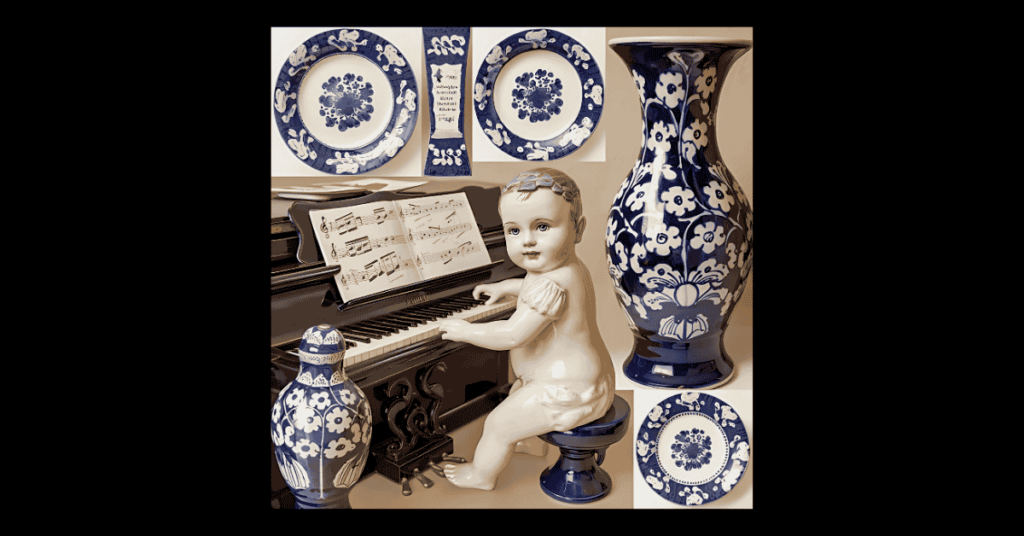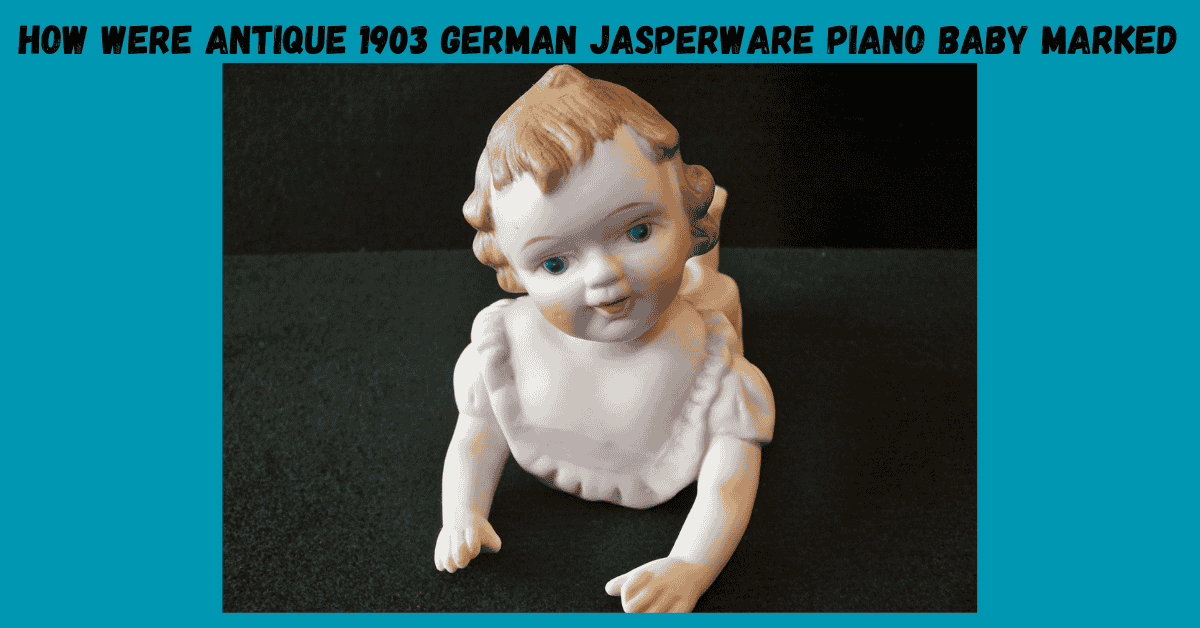how were antique 1903 German jasperware piano baby marked is a fascinating subject for collectors and enthusiasts alike. Understanding how these delicate items were marked can provide valuable insights into their origin, authenticity, and historical significance. This article delves into the intricate details of how antique 1903 German jasperware pianos were baby-marked, offering a comprehensive guide to help you identify and appreciate these charming collectibles.
The Rich Historical Background of German Jasperware
German jasperware, known for its fine craftsmanship and distinctive appearance, emerged as a popular collectable in the late 19th and early 20th centuries. Jasperware is a pottery known for its smooth, matte finish and ability to retain detailed designs. The term “piano baby” refers to small figurines often placed on pianos, hence the name. These items became especially popular during the early 1900s, and their unique markings help collectors distinguish between different manufacturers and periods.
Understanding the Marking System

To understand how were antique 1903 German jasperware piano baby marked, it’s essential to explore the marking system used during that era. Markings on these items often include the manufacturer’s logo, date codes, and sometimes specific designations. Typically, these marks were applied either on the bottom of the piece or inconspicuously on the side.
Manufacturer’s Logo
The manufacturer’s logo is the most prominent mark on How the antique 1903 German jasperware piano baby is marked. Renowned German pottery manufacturers such as Meissen, Rosenthal, and KPM (Königliche Porzellan-Manufaktur) were known for their high-quality work. Each manufacturer had distinctive logos that were carefully applied to their products. For instance, the Meissen mark typically includes crossed swords, while KPM’s logo might feature a royal crown.
Date Codes and Numbers
In addition to the manufacturer’s logo, many pieces of How were antique 1903 German jasperware piano baby marked also feature date codes or numerical markings. These codes indicated the year of production or specific design variations. Understanding these codes can provide valuable context for collectors, helping them to date and authenticate their pieces accurately.
Designation Marks
Somehow, how were antique 1903 German jasperware piano baby marked pieces might also feature designation marks, which provide additional information about the item’s design or purpose. For example, a piece might be marked with a specific pattern name or number, which can help collectors identify the particular design or style of the piano baby.
Read More: rupp rafters
Unveiling the Markings: How to Identify Antique 1903 German Jasperware Piano Babies
The markings play a crucial role when identifying authentic how antique 1903 German jasperware piano baby baby marked. Collectors should know the key features to look for and the common pitfalls to avoid.
Checking the Manufacturer’s Mark
One of the first steps in identifying how were antique 1903 German jasperware piano baby marked is to check the manufacturer’s mark. Genuine pieces from well-known manufacturers will have a clear and distinct logo. It’s important to compare the mark with known examples from reputable sources to ensure its authenticity.
Analyzing Date Codes
Date codes can provide additional confirmation of authenticity. Cross-referencing the date codes with historical records allows collectors to determine whether the piece was made in 1903 or at another time. Accurate date codes are crucial for verifying the item’s age and origin.
Examining Designation Marks
Designation marks can offer insights into the specific design and purpose of the piano baby. For example, if a piece is marked with a pattern name or number, collectors can use this information to trace its design history and confirm its authenticity.
Tracing Origins: The Importance of Provenance in Authenticating Antique

Provenance, or the history of an item’s ownership, can also play a significant role in verifying the authenticity of how were antique 1903 German jasperware piano baby marked. Provenance provides context for the item’s history and can help establish its legitimacy. Collectors should seek documentation or historical records that trace the piece’s origin and previous ownership.
Common Misconceptions About Markings
Several things could be improved about how were antique 1903 German jasperware piano baby marked. Understanding these misconceptions can help collectors avoid common mistakes and make informed purchase decisions.
Misconception: All Markings Are the Same
One common misconception is that all the how were antique 1903 German jasperware piano baby marked were marked with identical markings. Markings can vary significantly depending on the manufacturer and production period. Each manufacturer had its distinctive marking system, and even within a single manufacturer, markings might differ based on the year of production or design variations.
Misconception: Marks Always Indicate High Quality
Another misconception is that markings always indicate high quality. While markings can provide valuable information about the manufacturer and production date, they do not guarantee the item’s quality. In addition to examining the markings, it’s important to assess the overall craftsmanship and condition of the piece.
Expert Tips for Collecting and Preserving Antique 1903 German Jasperware Piano Babies
Several tips can help collectors interested in acquiring and preserving antique 1903 German jasperware piano baby marked to ensure the longevity and value of their collections.
Proper Handling and Storage
Proper handling and storage are crucial for preserving the condition of antique piano babies. Collectors should handle these items carefully, using gloves to avoid transferring oils or dirt from their hands. Additionally, storing the pieces in a controlled environment, away from direct sunlight and extreme temperatures, can help prevent damage.
Regular Cleaning and Maintenance
Regular cleaning and maintenance are essential for keeping antique jasperware in good condition. However, collectors should use gentle cleaning methods and avoid harsh chemicals that could damage the pottery’s delicate surface.
Seeking Professional Appraisal
For valuable or rare pieces, seeking a professional appraisal can provide additional insights into the item’s authenticity and value. Professional appraisers can offer expert opinions on the markings and overall quality of the piece.
FAQs About Antique 1903 German Jasperware Piano Babies
How can I identify the manufacturer of an antique 1903 German jasperware piano baby?
Look for the manufacturer’s logo, often placed on the bottom or side of the piece. Well-known German makers like Meissen and KPM have distinctive logos, such as crossed swords for Meissen.
What are date codes on antique 1903 German jasperware piano babies?
Date codes help identify when a piece was made, often consisting of numbers or symbols applied alongside the manufacturer’s mark.
Do all antique piano babies from 1903 have identical markings?
No, markings can vary between manufacturers and even within different production periods. Each maker had a unique marking system.
Can the markings on a piano baby guarantee its quality?
Markings indicate the origin and date but don’t guarantee quality. Inspect the craftsmanship and condition of the piece for a better assessment.
Ending Word’s
understanding how antique 1903 German jasperware piano babies were marked is essential for collectors to authenticate and appreciate these delicate pieces. By examining manufacturer logos, date codes, and designation marks, collectors can gain valuable insights into the origin and significance of each item. Proper preservation, careful handling, and professional appraisal ensure the longevity and value of these charming collectibles.
Stay Connected: Internetchicks.blog
